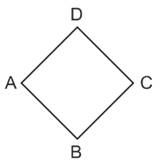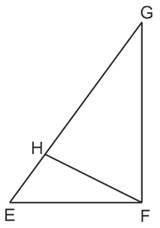
Geometry For Enjoyment And Challenge
91st Edition
ISBN: 9780866099653
Author: Richard Rhoad, George Milauskas, Robert Whipple
Publisher: McDougal Littell
expand_more
expand_more
format_list_bulleted
Concept explainers
Question
Chapter 2.1, Problem 1PSA
a)
To determine
To find:
a)
Expert Solution
Answer to Problem 1PSA
Explanation of Solution
Given information:

Find the line segments in given figures which seems to be perpendicular to each others
b)
To determine
To find: angles which are probably right angle
b)
Expert Solution
Answer to Problem 1PSA
Explanation of Solution
Given information:

Find the line segments in given figures which seems to be perpendicular to each others
Chapter 2 Solutions
Geometry For Enjoyment And Challenge
Ch. 2.1 - Prob. 1PSACh. 2.1 - Prob. 2PSACh. 2.1 - Prob. 3PSACh. 2.1 - Prob. 4PSACh. 2.1 - Prob. 5PSACh. 2.1 - Prob. 6PSACh. 2.1 - Prob. 7PSACh. 2.1 - Prob. 8PSACh. 2.1 - Prob. 9PSACh. 2.1 - Prob. 10PSA
Ch. 2.1 - Prob. 11PSBCh. 2.1 - Prob. 12PSBCh. 2.1 - Prob. 13PSBCh. 2.1 - Prob. 14PSCCh. 2.1 - Prob. 15PSCCh. 2.2 - Prob. 1PSACh. 2.2 - Prob. 2PSACh. 2.2 - Prob. 3PSACh. 2.2 - Prob. 4PSACh. 2.2 - Prob. 5PSACh. 2.2 - Prob. 6PSACh. 2.2 - Prob. 7PSACh. 2.2 - Prob. 8PSACh. 2.2 - Prob. 9PSACh. 2.2 - Prob. 10PSACh. 2.2 - Prob. 11PSACh. 2.2 - Prob. 12PSBCh. 2.2 - Prob. 13PSBCh. 2.2 - Prob. 14PSBCh. 2.2 - Prob. 15PSBCh. 2.2 - Prob. 16PSBCh. 2.2 - Prob. 17PSBCh. 2.2 - Prob. 18PSBCh. 2.2 - Prob. 19PSBCh. 2.2 - Prob. 20PSBCh. 2.2 - Prob. 21PSBCh. 2.2 - Prob. 22PSBCh. 2.2 - Prob. 23PSBCh. 2.2 - Prob. 24PSBCh. 2.2 - Prob. 25PSCCh. 2.2 - Prob. 26PSCCh. 2.3 - Prob. 1PSACh. 2.3 - Prob. 2PSACh. 2.3 - Prob. 3PSACh. 2.3 - Prob. 4PSACh. 2.3 - Prob. 5PSACh. 2.3 - Prob. 6PSACh. 2.3 - Prob. 7PSACh. 2.3 - Prob. 8PSACh. 2.3 - Prob. 9PSBCh. 2.3 - Prob. 10PSBCh. 2.3 - Prob. 11PSBCh. 2.3 - Prob. 12PSBCh. 2.3 - Prob. 13PSCCh. 2.3 - Prob. 14PSCCh. 2.4 - Prob. 1PSACh. 2.4 - Prob. 2PSACh. 2.4 - Prob. 3PSACh. 2.4 - Prob. 4PSACh. 2.4 - Prob. 5PSACh. 2.4 - Prob. 6PSACh. 2.4 - Prob. 7PSACh. 2.4 - Prob. 8PSACh. 2.4 - Prob. 9PSACh. 2.4 - Prob. 10PSBCh. 2.4 - Prob. 11PSBCh. 2.4 - Prob. 12PSBCh. 2.4 - Prob. 13PSBCh. 2.4 - Prob. 14PSBCh. 2.4 - Prob. 15PSBCh. 2.4 - Prob. 16PSBCh. 2.4 - Prob. 17PSBCh. 2.4 - Prob. 18PSBCh. 2.4 - Prob. 19PSBCh. 2.4 - Prob. 20PSCCh. 2.4 - Prob. 21PSCCh. 2.5 - Prob. 1PSACh. 2.5 - Prob. 2PSACh. 2.5 - Prob. 3PSACh. 2.5 - Prob. 4PSACh. 2.5 - Prob. 5PSACh. 2.5 - Prob. 6PSACh. 2.5 - Prob. 7PSACh. 2.5 - Prob. 8PSACh. 2.5 - Prob. 9PSACh. 2.5 - Prob. 10PSACh. 2.5 - Prob. 11PSBCh. 2.5 - Prob. 12PSBCh. 2.5 - Prob. 13PSBCh. 2.5 - Prob. 14PSBCh. 2.5 - Prob. 15PSBCh. 2.5 - Prob. 16PSBCh. 2.5 - Prob. 17PSCCh. 2.5 - Prob. 18PSCCh. 2.5 - Prob. 19PSCCh. 2.6 - Prob. 1PSACh. 2.6 - Prob. 2PSACh. 2.6 - Prob. 3PSACh. 2.6 - Prob. 4PSACh. 2.6 - Prob. 5PSACh. 2.6 - Prob. 6PSACh. 2.6 - Prob. 7PSACh. 2.6 - Prob. 8PSACh. 2.6 - Prob. 9PSACh. 2.6 - Prob. 10PSACh. 2.6 - Prob. 11PSBCh. 2.6 - Prob. 12PSBCh. 2.6 - Prob. 13PSBCh. 2.6 - Prob. 14PSBCh. 2.6 - Prob. 15PSCCh. 2.6 - Prob. 16PSCCh. 2.7 - Prob. 1PSACh. 2.7 - Prob. 2PSACh. 2.7 - Prob. 3PSACh. 2.7 - Prob. 4PSACh. 2.7 - Prob. 5PSACh. 2.7 - Prob. 6PSACh. 2.7 - Prob. 7PSACh. 2.7 - Prob. 8PSACh. 2.7 - Prob. 9PSACh. 2.7 - Prob. 10PSBCh. 2.7 - Prob. 11PSBCh. 2.7 - Prob. 12PSBCh. 2.7 - Prob. 13PSBCh. 2.7 - Prob. 14PSBCh. 2.7 - Prob. 15PSBCh. 2.7 - Prob. 16PSCCh. 2.7 - Prob. 17PSCCh. 2.7 - Prob. 18PSDCh. 2.7 - Prob. 19PSDCh. 2.7 - Prob. 20PSDCh. 2.8 - Prob. 1PSACh. 2.8 - Prob. 2PSACh. 2.8 - Prob. 3PSACh. 2.8 - Prob. 4PSACh. 2.8 - Prob. 5PSACh. 2.8 - Prob. 6PSACh. 2.8 - Prob. 7PSACh. 2.8 - Prob. 8PSACh. 2.8 - Prob. 9PSBCh. 2.8 - Prob. 10PSBCh. 2.8 - Prob. 11PSBCh. 2.8 - Prob. 12PSBCh. 2.8 - Prob. 13PSBCh. 2.8 - Prob. 14PSBCh. 2.8 - Prob. 15PSCCh. 2 - Prob. 1RPCh. 2 - Prob. 2RPCh. 2 - Prob. 3RPCh. 2 - Prob. 4RPCh. 2 - Prob. 5RPCh. 2 - Prob. 6RPCh. 2 - Prob. 7RPCh. 2 - Prob. 8RPCh. 2 - Prob. 9RPCh. 2 - Prob. 10RPCh. 2 - Prob. 11RPCh. 2 - Prob. 12RPCh. 2 - Prob. 13RPCh. 2 - Prob. 14RPCh. 2 - Prob. 15RPCh. 2 - Prob. 16RPCh. 2 - Prob. 17RPCh. 2 - Prob. 18RPCh. 2 - Prob. 19RPCh. 2 - Prob. 20RPCh. 2 - Prob. 21RPCh. 2 - Prob. 22RPCh. 2 - Prob. 23RPCh. 2 - Prob. 24RPCh. 2 - Prob. 25RPCh. 2 - Prob. 26RPCh. 2 - Prob. 27RPCh. 2 - Prob. 28RPCh. 2 - Prob. 29RPCh. 2 - Prob. 30RPCh. 2 - Prob. 31RPCh. 2 - Prob. 32RPCh. 2 - Prob. 33RPCh. 2 - Prob. 34RPCh. 2 - Prob. 35RPCh. 2 - Prob. 36RPCh. 2 - Prob. 37RPCh. 2 - Prob. 38RP
Additional Math Textbook Solutions
Find more solutions based on key concepts
Evaluating limits Evaluate the following limits. 31. limx35x4x3
Calculus: Early Transcendentals (2nd Edition)
Fill in each blanks so that the resulting statement is true. Any set of ordered pairs is called a/an _______. T...
College Algebra (7th Edition)
The equivalent expression of x(y+z) by using the commutative property.
Calculus for Business, Economics, Life Sciences, and Social Sciences (14th Edition)
Shell method about other lines Let R be the region bounded by y = x2, x = 1, and y = 0. Use the shell method to...
Calculus: Early Transcendentals (2nd Edition)
Standard Normal Distribution. In Exercises 17–36, assume that a randomly selected subject is given a bone densi...
Elementary Statistics (13th Edition)
Knowledge Booster
Learn more about
Need a deep-dive on the concept behind this application? Look no further. Learn more about this topic, geometry and related others by exploring similar questions and additional content below.Similar questions
- 10 20 30 y vernier protractor scales. 60 30 0 30 60 40 30 20 10 0 30 60 0 10. Write the complement of each of the following angles. a. 67° b. 17°41' 11. Write the supplement of each of the following angles. a.41° b.99°32' 30 60 C. 20 10 20 90 60 30 69 30 30 40 50 c. 54°47' 53" 0 30 60 c. 103°03'27" 12. Given: AB CD and EF GH. Determine the value of each angle, 21 through /10, to the nearer minute. A- 25 21 = 22 = 23 = 24 = 25 = 46= 27 = C 28 = 29 = 210 = E 26 22 210 81°00' 29 4 142°00' G H 94°40' B Darrow_forwardName: Tan Tong 16.5 Bonvicino - Period 5 1 Find the exact volume of a right hexagonal prism such that the base is a regular hexagon with a side length of 8 cm and whose distance between the two bases is 5 cm. Show all work. (4 pts) 83 tan 30°= Regular hexagon So length ~ 480 tango Cm Hexagon int angle =36016 8cm Angle bisec isper p bisect Side length 4 X=an 300 2 In the accompanying diagram of circle O, PA is tangent to the circle at A, PDC is a secant, diameter AEOC intersects chord BD at E, chords AB, BC, and DA are drawn, mDA = 46° and mBC is 32° more than mAB. If the radius of the circle is 8 cm, E is the midpoint of AO and the length of ED is 2 less than the length of BE, answer each of the following. Show all work. (a) marrow_forward18:36 G.C.A.2.ChordsSecantsandTa... จ 76 完成 2 In the accompanying diagram, AABC is inscribed in circle O, AP bisects BAC, PBD is tangent to circle O at B, and mZACB:m/CAB:m/ABC= 4:3:2 D B P F Find: mZABC, mBF, m/BEP, m/P, m/PBC ← 1 Őarrow_forward14:09 2/16 jmap.org 5G 66 In the accompanying diagram of circle O, diameters BD and AE, secants PAB and PDC, and chords BC and AD are drawn; mAD = 40; and mDC = 80. B E Find: mAB, m/BCD, m/BOE, m/P, m/PAD ← G.C.A.2.ChordsSecantsand Tangent s19.pdf (538 KB) + 4 保存... Xarrow_forward16:39 < 文字 15:28 |美图秀秀 保存 59% 5G 46 照片 完成 Bonvicino - Period Name: 6. A right regular hexagonal pyramid with the top removed (as shown in Diagram 1) in such a manner that the top base is parallel to the base of the pyramid resulting in what is shown in Diagram 2. A wedge (from the center) is then removed from this solid as shown in Diagram 3. 30 Diogram 1 Diegrom 2. Diagram 3. If the height of the solid in Diagrams 2 and 3 is the height of the original pyramid, the radius of the base of the pyramid is 10 cm and each lateral edge of the solid in Diagram 3 is 12 cm, find the exact volume of the solid in Diagram 3, measured in cubic meters. Show all work. (T 文字 贴纸 消除笔 涂鸦笔 边框 马赛克 去美容arrow_forwardAnswer question 4 pleasearrow_forward16:39 < 文字 15:28 |美图秀秀 保存 59% 5G 46 照片 完成 Bonvicino - Period Name: 6. A right regular hexagonal pyramid with the top removed (as shown in Diagram 1) in such a manner that the top base is parallel to the base of the pyramid resulting in what is shown in Diagram 2. A wedge (from the center) is then removed from this solid as shown in Diagram 3. 30 Diogram 1 Diegrom 2. Diagram 3. If the height of the solid in Diagrams 2 and 3 is the height of the original pyramid, the radius of the base of the pyramid is 10 cm and each lateral edge of the solid in Diagram 3 is 12 cm, find the exact volume of the solid in Diagram 3, measured in cubic meters. Show all work. (T 文字 贴纸 消除笔 涂鸦笔 边框 马赛克 去美容arrow_forwardAnswer question 3 pleasearrow_forwardAnswer question 3 pleasearrow_forward38 Below triangle is isosceles. Find the value of x. 70° 60° x 20° Warrow_forwardTo approximate the length of a marsh, a surveyor walks x = 400 meters from point A to point B. Then, the surveyor turns 75° and walks 220 meters to point C (see figure). Approximate the length AC of the marsh. (Round your answer to one decimal place.) m C B 75° 220 m x marrow_forward. The students who attend Memorial High School have a wide variety of extra-curricular activities to choose from in the after-school program. Students are 38% likely to join the dance team; 18% likely to participate in the school play; 42% likely to join the yearbook club; and 64% likely to join the marching band. Many students choose to participate in multiple activities. Students have equal probabilities of being freshmen, sophomores, juniors, or seniors.What is the probability of the union of being either a freshman or senior? 0.07 0.44 0.50 0.25arrow_forwardarrow_back_iosSEE MORE QUESTIONSarrow_forward_ios
Recommended textbooks for you
 Elementary Geometry For College Students, 7eGeometryISBN:9781337614085Author:Alexander, Daniel C.; Koeberlein, Geralyn M.Publisher:Cengage,
Elementary Geometry For College Students, 7eGeometryISBN:9781337614085Author:Alexander, Daniel C.; Koeberlein, Geralyn M.Publisher:Cengage, Elementary Geometry for College StudentsGeometryISBN:9781285195698Author:Daniel C. Alexander, Geralyn M. KoeberleinPublisher:Cengage Learning
Elementary Geometry for College StudentsGeometryISBN:9781285195698Author:Daniel C. Alexander, Geralyn M. KoeberleinPublisher:Cengage Learning

Elementary Geometry For College Students, 7e
Geometry
ISBN:9781337614085
Author:Alexander, Daniel C.; Koeberlein, Geralyn M.
Publisher:Cengage,

Elementary Geometry for College Students
Geometry
ISBN:9781285195698
Author:Daniel C. Alexander, Geralyn M. Koeberlein
Publisher:Cengage Learning
01 - Angles and Angle Measure in Degrees - Part 1 - Types of Angles & What is an Angle?; Author: Math and Science;https://www.youtube.com/watch?v=hy95VyPet-M;License: Standard YouTube License, CC-BY